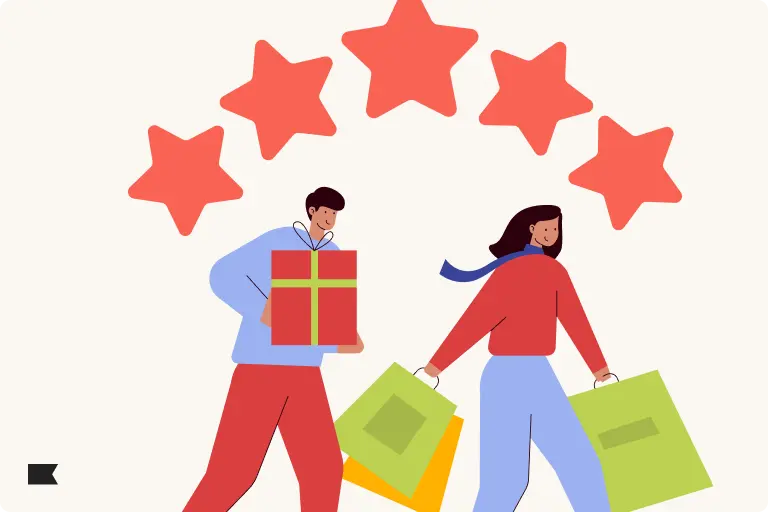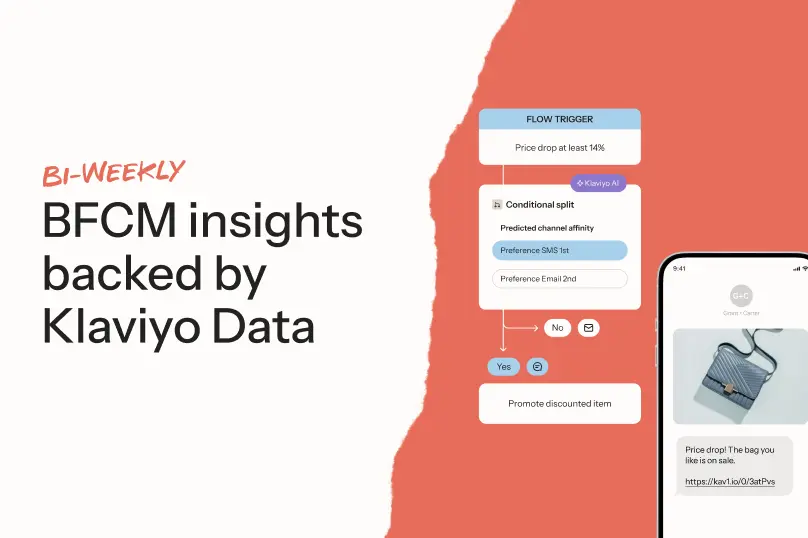9 actionable tips for staying profitable during BFCM

Staying profitable during Black Friday Cyber Monday is a balancing act. This year, economic uncertainty is keeping brands on their toes—and making it a good time to focus on resiliency.
While BFCM is one of the best times to boost sales and acquire new customers, the key to long-term success lies in not just increasing revenue, but also maintaining healthy profits throughout this high-stakes shopping season. Remember: BFCM is not a revenue contest. It’s a contribution-margin contest.
Of course, BFCM success is easier said than done.
I’m the founder of Polaris Growth, where we’ve helped more than 60 ecommerce brands use Klaviyo to optimize their marketing efforts. And each year, I see opportunities for businesses to increase growth and profitability during this short but peak shopping season.
For every tactic in this guide, use this one-line check: does it raise contribution margin after cost of goods sold, shipping, payment fees, expected returns, and media? If not, don’t run it.
1. Offer profit-friendly incentives
Intense discounts can put a squeeze on your margins during BFCM. But it doesn’t have to be that way.
Here are some ways to create value for customers without sacrificing a good chunk of your profits.
This approach involves combining multiple products into a single package deal, at a price that’s slightly lower than buying each item separately. Customers feel they’re getting more for their money—even if the discount per item is modest.
By carefully selecting which products to bundle, you protect your overall margins.
Black Friday profit pro tip: Use product analysis insights under Klaviyo Marketing Analytics to automate bundle and co-purchase recommendations.
For instance, you can offer 10% off orders over $50, 15% off orders over $100, and 20% off orders over $150. This approach incentivizes customers to add more items to their cart to reach the next discount tier, boosting your overall average order value (AOV).
Instead of discounts, you can offer customers a sample-sized product, a branded accessory, or a limited-edition item. The perceived value of a free gift often outweighs its cost to you, making this a great way to attract customers without significantly impacting your margins.
“Tiered free gifts are one of the few BFCM incentives that let you create perceived value without putting your margins through the meat grinder,” says Ben Zettler, founder of Zettler Digital. “Choose gifts that are high impact for the customer, low cost for you, and aligned with what you want to move.”
“This is also a smart way to clear out slow-moving inventory, as long as each tier feels intentional,” Zettler adds. “Position the gifts as exclusive, not just leftovers. That way, your AOV climbs and your profit doesn’t get torched.”
Consider running unique, limited early-access deals. If you bake in a higher margin, and the segment properly, the sale can feel like a win for the shopper without you eroding your margins.
Black Friday profit pro tip: Send this deal to subscribers who have been on your list for 3+ months but haven’t purchased yet.
2. Tailor your marketing to high-value segments
I’m a big fan of using Klaviyo’s customer segmentation because it’s a high-impact, low-effort way to protect your margins.
One of my favorite use cases around BFCM is to create segments for VIP customers based on their spending habits or purchase frequency.
There are 3 primary approaches to take when deciding who your VIP customers are:
| Segment | Approach |
| 1. Big spenders | Identify customers who have spent over a certain amount in the last 365 days. |
| 2. Frequent purchasers | Send to customers who have made a specific number of purchases in the last 365 days. |
| 3. Blended approach | Combine spending and frequency thresholds to capture your most valuable customers. |
Once you’ve identified your VIPs, you can nurture these relationships with exclusive offers, early access to BFCM sales, or personalized bundles.
“Some brands make the mistake of blasting the same BFCM offer to everyone,” says Zettler. “While BFCM often means discount offers are involved, not every customer is a bargain shopper. Segmentation lets you invite loyalists and high-LTV customers to exclusive product launches instead of just giving them a coupon. You can deepen your loyalty and keep your margins intact.”
Segmentation lets you deepen your loyalty and keep your margins intact.
3. Take advantage of opportunities to up- and cross-sell
When people are already shopping in your store or on your website during BFCM, there’s an opportunity to boost your AOV via up- and cross-selling. One way to do this is by providing on-site recommendations for related or upgraded products.
For example, if you’re a footwear brand and a customer is browsing for running shoes, you can display a section titled “Complete Your Running Gear”—featuring moisture-wicking socks, running shorts, and a water bottle. You can even position these as stocking stuffers to spark gift ideas for customers.
For carts that have a high AOV, consider putting a Klaviyo pop-up on the cart with lower-cost impulse purchase products. This can help you to increase a bit of AOV.
You can also use integrations like OrderEditing that allow people to make changes to their order before it ships, without having to directly contact customer support.
But even after a customer completes a purchase, there’s opportunity to capture more revenue.
I encourage my clients to implement up- or cross-sell email flows to follow up after a purchase—whether that’s by sending personalized recommendations a few weeks after BFCM, or offering a one-time special deal on a related product immediately after the purchase.
Ashley Ismailovski, director of email marketing at SmartSites, uses Klaviyo AI to send cross-sell messages at exactly the right time for each individual customer. In the product analysis dashboard, “use the ‘next best cross-sell date’ flow trigger to send an email to a customer when Klaviyo’s predictive analytics model has determined they would be most receptive to a cross-sell promotion,” she advises.
“Use the ‘next best cross-sell date flow trigger to send an email to a customer when Klaviyo’s predictive analytics model has determiend they’d be most receptive to a cross-sell promotion.
“If you want to take it a step further,” Ismailovski says, “you can also use the ‘next best product’ block in your message to show the customer personalized product recommendations based on their previous purchases.”
Black Friday profit pro tip: You can communicate these reminders across more than just email. Use SMS, paid ads, web, and social to up- and cross-sell during this time, too.
4. Optimize for profit on ad spend
Make every ad dollar count during BFCM by optimizing for profit on ad spend (POAS) rather than just return on ad spend (ROAS).
While ROAS measures the gross revenue generated for every dollar spent on advertising, POAS takes into account your profit margins. So even though a campaign with a 4x ROAS might seem successful, your POAS may show otherwise.
This is especially important during BFCM when many businesses offer significant discounts. POAS also factors in costs like shipping, payment processing fees, and product costs, which can fluctuate during high-volume sales periods like BFCM.
To optimize your POAS, focus on advertising high-margin products. While the definition of a high margin will depend on the industry, in general I’d encourage brands to focus on the top 20% most profitable products that they’re selling.
You can also utilize CLV in your CRM strategy. Again, I like to use Klaviyo’s segmentation to create highly targeted audiences for BFCM ads, such as a lookalike audience based on the highest-CLV customers.
Jemma Sears, digital marketing manager at Kulani Kinis, a swimwear brand based in Australia, uses Klaviyo’s integration with Meta and Klaviyo Audience Sync to personalize paid ads to show the exact print a shopper subscribed to a back-in-stock notification for.
“This is an effective way to leverage demand with a high-intent audience,” Sears shares. “We saw a reduced cost per acquisition with this audience compared to our typical remarketing audiences. It was over $10 cheaper to convert our Klaviyo audiences—quite compelling when you look at scaling this strategy.”
It was over $10 cheaper to convert our Klaviyo audiences—quite compelling when you look at scaling this strategy.
5. Avoid promoting high-return products
One easy way to minimize costly returns is to avoid heavy promotion of products with high return rates.
US retailers expect holiday returns to be about 17% higher than the annual rate in 2024, according to research conducted by the National Retail Federation.
Since return rates can vary significantly depending on the industry, use benchmark data to gauge whether the rates for a certain product are considered high. Or, if you have access to your BFCM data from last year, use that to identify which of your products had the highest return rates.
The main problem you’re trying to prevent is promoting products that, on average, have the highest return rate in your assortment.
While many factors can impact returns, you want to minimize the chances of paying top dollar to get people to your shop—only to create even more work and costs for your team because you chose to market the wrong product.
Here are some ways to manage the problem of high returns around BFCM:
- Build a returns reserve into your profit and loss statement.
- Cap discounts on historically high-return categories.
- Put a lower ceiling on discounts for categories with above-average return rates.
- Promote bundles and add-ons for those categories to raise perceived value without deep cuts.
Returns will always cost businesses money, but these tactics will better protect your profits and ensure a better customer experience.
6. Promote profitable payment and shipping methods
While most brands focus on the shopping experience, it’s equally important to pay attention to what comes after: payment and shipping.
Here are two ways to guide customers toward options that benefit your bottom line:
Different payment methods come with varying transaction costs for your business. Find ways to nudge customers toward the lower-fee options.
For instance, you can offer a small discount for using certain payment methods. To figure out how much of a discount to offer, start by comparing payment methods and measuring the difference between those options. The goal, of course, is to promote the cheaper alternative for your business. Keep in mind that returns may have additional handling costs as well.
Black Friday profit pro tip: For the European Union, make sure you adhere to regulations.
Consider providing free shipping with minimum order values set above the AOV, which can increase average order size while keeping shipping costs manageable.
You can also look at the cost of each shipment carrier and promote the cheapest options, while adding a small fee for the more expensive ones.
7. Prevent buyer’s remorse
Reduce returns and build customer satisfaction by implementing post-purchase email flows that reinforce the value of people’s BFCM purchases. A few ideas:
- Send a celebratory “Your order is on the way” email after the package ships to build excitement.
- Share usage or educational tips for the product someone purchased to help them get the most value out of it.
- Showcase user-generated content featuring the product a customer purchased for inspiration.
Black Friday profit pro tip: When returns are necessary, prioritize exchanges or store credit over refunds to retain the customer’s business.
8. Give back to a good cause
Consider donating a portion of your BFCM profits to a charity that aligns with your brand values.
If you sell outdoor gear, for instance, you might partner with an environmental conservation organization.
You can then create a special BFCM collection where a higher percentage of sales goes to charity, or offer customers the option to round up their purchase to the nearest dollar for donation.
This approach not only contributes to a good cause, but can also account for premium pricing and attract customers who want their purchases to make a positive impact. Just ask London Sock Co.—when the brand donated two pairs of socks to a homeless charity for every purchase during BFCM, the strategy contributed to a 180% increase in AOV during the sale period.
9. Re-engage customers post-BFCM
Don’t let your BFCM customers disappear after the holidays. Here are a few ideas to re-engage customers after the holiday rush dies down:
1. Implement robust follow-up marketing campaigns
With Klaviyo, you can tailor your messages based on purchase history and LTV. For instance, create a segment of first-time BFCM buyers and send them a welcome series that introduces your brand story, showcases your bestselling products, and offers a small incentive for their next purchase.
George Rodríguez, founder of A-Game Digital, recommends compressing the typical 30-day sales window after BFCM. “We’re creating time pressure and telling customers, ‘If you know you’ll need this item again, grab it soon instead of waiting,'” he explains.
Here’s how Rodríguez’s team at A-Game approaches this:
- Use marketing analytics to identify products with strong repeat buying patterns or natural cross-sell potential.
- Develop time-sensitive messaging emphasizing the brief availability of winter holiday promotions.
- Highlight complementary products that work well together with customers’ original selections.
2. Don’t forget about your existing customers
After BFCM, send existing customers personalized product recommendations based on their recent buys, or create an exclusive “loyal customer” offer for the new year.
Rodríguez suggests personalizing the follow-up offer based on the customer’s RFM segment. “If it’s a new customer in the ‘Recent’ segment, use language that acknowledges their current status in the lifecycle and highlight what most customers buy next,” he advises. “And be sure to emphasize that they’re getting a deal due to the holiday.”
“If they’re a ‘Champion’ customer, thank them for their loyalty and present the offer graciously,” Rodríguez adds. “If they’ve churned, welcome them back and thank them with a follow-up offer they can use now or share with friends and family.”
3. Find out how your customers experienced shopping with you
A post-purchase survey is a great way to gather feedback and improve future campaigns, while also keeping your brand top of mind for customers.
If you use Klaviyo Customer Hub, the “Service interactions”section will show you which self-service support interactions your customers have taken. This can help you find weak spots in your customer journey so you can improve future experiences.
Tracked service interactions include:
- Orders tracked
- Returns started
- Coupons applied
- Clicks on the help buttons
- Web chat conversations started
By focusing on these post-BFCM engagement strategies, you can turn one-time holiday shoppers into year-round revenue drivers, maximizing the long-term value of your BFCM efforts.
Use these strategies to protect your hard-earned BFCM profits
I’ve seen firsthand how these strategies can help brands keep more money in their pockets during and after the holiday season. Start planning to implement these strategies right now to help make your BFCM as profitable as possible.

Related content

Learn 5 ways to turn new holiday shoppers into repeat buyers using personalization, seamless returns, targeted outreach, and AI-driven customer experiences.

Learn what to include in your photography style guide to create consistent, on-brand visuals across your B2C marketing channels.

Shopping is about to hit its peak season. But this year’s surge will look different from those before it. Instead of impulsive buying sprees, shoppers are entering the holidays with a more deliberate mindset.